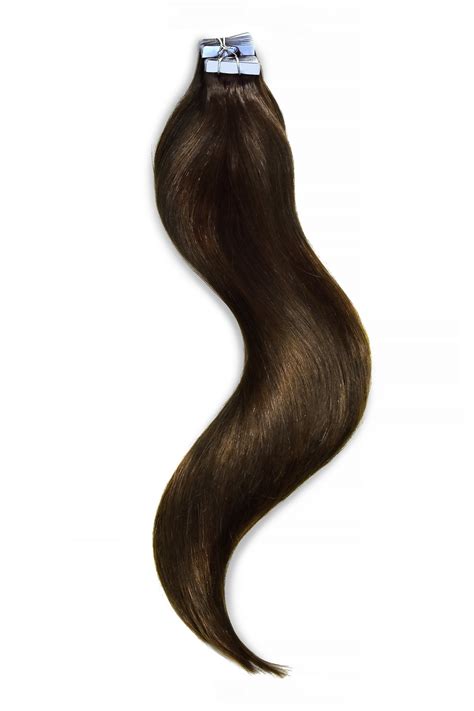Tape-in hair extensions have gained immense popularity among hair enthusiasts seeking a convenient and versatile solution to enhance their hair volume and length. These extensions, made with 100% human hair, seamlessly blend with natural hair and offer a natural appearance. With proper care and maintenance, tape-in extensions can last for several months, making them an excellent investment for those seeking a long-term hair solution.

Understanding Tape-In Hair Extensions
Tape-in hair extensions consist of individual hair wefts attached to a thin, adhesive tape. The wefts are then applied to the root area of the natural hair, creating a secure and concealed bond. The tape is specially formulated to hold the extensions securely without damaging the natural hair.
Benefits of Tape-In Extensions
- Convenient Application: Tape-in extensions can be applied in a matter of hours, making them a time-efficient solution compared to other extension methods.
- Versatility: These extensions can be customized to match the length, volume, and texture of natural hair, offering a wide range of styling options.
- Long-Lasting: With proper care, tape-in extensions can last for up to 12 months, making them a cost-effective investment.
- Natural Appearance: The thin tape and seamless application create a natural-looking blend with the natural hair, ensuring an undetectable appearance.
- Minimal Damage: Unlike other extension methods, tape-in extensions do not require heat or glue, minimizing potential damage to natural hair.
Considerations Before Applying Tape-In Extensions
- Hair Type: Tape-in extensions are suitable for all hair types, including fine, thick, curly, and straight hair. However, they may not be ideal for those with very short or extremely damaged hair.
- Hair Texture: The texture of the extensions should closely match the natural hair texture to ensure a seamless blend.
- Hair Density: The number of extensions required will depend on the desired volume and length. Consult with a professional stylist to determine the appropriate quantity.
- Lifestyle: Tape-in extensions require regular maintenance and care. Individuals with an active lifestyle or those who regularly participate in water-based activities may need to adjust their maintenance routine.
Step-by-Step Application Process
Materials:
- Tape-in hair extensions
- Measuring tape
- Sectioning clips
- Brush or comb
- Scissors
- Hair extension pliers
Steps:
- Section Hair: Part the hair into several horizontal sections, starting from the nape of the neck. Secure each section with clips.
- Prepare Extensions: Remove a few inches of adhesive tape from the back of the hair weft.
- Attach Extension: Place the exposed adhesive area on the root of the natural hair, about 1/2 inch from the scalp. Press firmly.
- Add Sandwiching Extension: Place another weft on top of the first, sandwiching the natural hair in between. Press firmly to secure.
- Seal Tape: Use hair extension pliers to seal the tape and create a strong bond.
- Repeat: Repeat steps 2-5 for the remaining wefts, moving upwards in sections.
- Style: Blend the extensions with natural hair using a brush or comb, and style as desired.
Tips and Tricks
- Use a heat protectant spray to prevent heat damage when styling.
- Avoid excessive brushing or combing, as this can loosen the tape.
- Wash hair less frequently, as water can loosen the adhesive.
- Use a sulfate-free shampoo and conditioner to extend the life of the extensions.
- Get regular maintenance appointments (every 6-8 weeks) to adjust the extensions and check for any slippage.
Table 1: Benefits vs. Drawbacks of Tape-In Extensions
| Benefits | Drawbacks |
|---|---|
| Convenient application | Requires regular maintenance |
| Versatile | May not be suitable for all hair types |
| Long-lasting | Can be more expensive than other extension methods |
| Natural appearance | Potential for slippage |
| Minimal damage | Application requires professional expertise |
Table 2: Estimated Costs of Tape-In Extensions
| Hair Length | Number of Wefts | Price Range |
|---|---|---|
| 14-16 inches | 10-12 | $250-$500 |
| 18-20 inches | 12-14 | $300-$600 |
| 22-24 inches | 14-16 | $350-$700 |
Table 3: Maintenance Routine for Tape-In Extensions
| Task | Frequency |
|---|---|
| Wash hair | Every 3-4 days |
| Condition hair | After each wash |
| Brush hair | Daily |
| Apply heat protectant | Before using heat styling tools |
| Get maintenance appointments | Every 6-8 weeks |
Table 4: Innovative Uses of Tape-In Extensions
| Use | Description |
|---|---|
| Halo Extension: Multiple wefts of tape-in extensions are sewn together to create a halo-shaped piece that can be easily clipped in and out. | |
| Bangs Extension: A small number of tape-in wefts can be applied to create temporary bangs without the need for a haircut. | |
| Undercut Extension: Tape-in extensions can be used to fill in the gaps created by an undercut hairstyle. | |
| Color Correction Extension: Extensions can be used to add |
